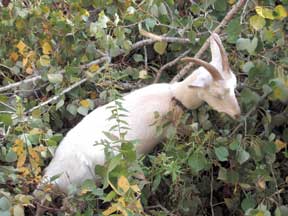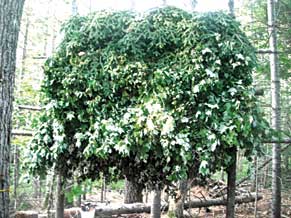 |
| A 20-year-old short black poplar that Paul Hand has pollarded in England. Photo by Shana Hanson |
 |
| Two comparable ash trees in September 2016 – one initially pruned in summer 2015 and thriving, the other suffering from drought until it was pruned after the photo was taken. Photo by Shana Hanson |
 |
| Cut fodder is first browsed where it falls, to lighten labor. Photo by Shana Hanson |
 |
| Our seminar’s rack of twig-leaf sheaves, protected by a fir bough “roof.” Photo by Shana Hanson |
 |
| Example of a rack. Photo courtesy of Håkan Slotte |
By Shana Hanson
Across climates and times of change, farmers worldwide have relied upon forests for stable animal rations. Trees are optimally structured to build soil and ecological health around their own deep roots, and their leaves and branches can benefit the farm food chain.
For 8,000 years, livestock ingested and bedded in tree leaves, thus concentrating carbon, nitrogen, minerals and microbial life wherever humans settled. Trees and bushes were too valuable to be cleared from hay fields and pastures; instead they were pollarded – cut in ways that promoted young shoot growth above browse height. Those shoots could be harvested for livestock fodder every three to eight years, for hundreds of years on one tree. In some languages a woodland thus cultured was called an “air meadow” or “the meadow in the air.”
Pollarding nourishes the grazable plant growth or hay crop beneath the trees as well, through annual leaf drop and through nitrogen released when the root system dies back after each leaf fodder harvest. Historically, the heavily and cyclically pruned trees (pollards) were rejuvenated at each re-growth and were trained to stable forms, causing phenomenal life expectancies. Less efficient annual and biennial crops in full sun depended on the generous flow of fertility from tree-based manure and bedding materials.
Last July at my 3 Streams Farm in Belfast, Maine, farmers and students from three U.S. states, Canada, Russia and France intently considered and practiced tree leaf fodder production and storage. We called the seminar “Boosting Climate Resilience and Biodiversity in Perennial Farm Ecosystems through Use of Air Meadow Pollarding” (aka “Tree Fodder Seminar 2016”).
Presenters at the seminar shared valuable information based on their experiences. Michael Walder of Mahna Farm in Ontario, for instance, said that he prunes for two hours or less daily with hand tools and arborist skills to feed 250 to 350 pounds edible portion of tree prunings per day to 32 meat goats (10 dams, 18 kids, two sires and two adolescents; see Acres USA, May 2017).
Carol Kinsey from Seed Tree in Stockton Springs, Maine, said that Seed Tree includes several fodder tree species in its Nepal Tree Planting Program and requires planting fodder trees as part of any loan involving livestock there.
Mark Fulford of Teltane Farm in Monroe, Maine, said that biocharring woody feed refuse makes an optimal soil amendment, especially when the biochar is ingested and then excreted by livestock. For more on this topic, including feeding rates, search for “biochar” in Ithaka – Journal for ecology, winegrowing and climate farming (https://www.ithaka-journal.net/).
Paul Hand, head of Bees and Trees, UK, which saves rare tree and nut varieties, said he restores 200- to 500-year-old live black poplar pollards and wants children to plant replacement trees from cuttings to feed pet rabbits and guinea pigs.
Dave Rocque, Maine state soil scientist, showed how to use a soil auger and a skilled eye to locate optimum microsites specific to tree species.
Benjamin Bouchard of Baryonyx Knife Company, now in Shapleigh, Maine, demonstrated skilled use of a bill hook – a tool for tree fodder harvest, hedge laying and more.
Stephen Byers, a clinical herbalist based in Belfast, Maine, discussed using various branches and leaves cut for fodder for herbal medicine for humans.
Morten Moesswilde, Maine state forester (and secretly landscape historian), noted how tree fodder use rose and fell regionally with site-specific European industries, and how weather and glacial paths interacting with mountain ranges caused tree species to shift, and will continue to do so.
Fred Servello of the University of Maine related his extensive body of deer browse research to goat browse data at 3 Streams Farm, and wrote “Nutritional Ecology of Domestic Goats Using Woodland Forages in Maine – What Research on Wild Herbivores Tells Us,” a Q and A document to guide observation and discussion during a seminar browse walk. Email [email protected] for a copy.
I study traditional air meadow practices to develop optimum FHD – foliage (or fodder!) height diversity – in the 3 Streams Farm woodland. Foliage height diversity correlates with high species counts. The more diverse the foliage height, the greater the number of species – microbes, fungi, insects, animals, plants, everyone! – that will live in a given place. Lush ground and shrub layers are sheltered by a multi-storied fodder canopy that is deeply complex for optimum capture of sunlight. I propose based on multi-aged forestry data (“Multiaged Silviculture: Managing for Complex Forest Stand Structures,” by Kevin O’Hara, Oxford University Press, 2014; see especially graph on p. 211) that air meadow pruning in 3- to 8-year cycles will maximize carbon storage, certainly in the trees and probably in the soil as well, with smaller dips in carbon storage after cuttings than with other recommended ecological forestry approaches. A farmer can help stabilize climate by feeding tree fodder.
Trees properly pollarded show resilience to both drought and, in damp seasons, to fungi. Tree leaf hay (tree leaves dried and stored for feeding to livestock in winter) dries without molding, even if stacked and covered when freshly cut. Yield and feed value per well managed area is comparable to that of a good hay meadow ( “Tankar wid skötseln och nyttan af boskap och fjäderfä, med botemedel i vanlige och mäst tillfällige siukdomar, samt skogars bruk och missbruk I alla derå grundade hushållsmål,” by Johann Brauner, 1756, Stockholm). Nutrition varies by species, soil quality, weather and cut date (usually late August into fall), with elms, ashes, oaks, basswoods, cherries, black locust, honeylocust, yellow birch, willows and poplars being top choices. Cherry leaves are dangerous to livestock when wilted (my goats reject these), yet valuable both fresh and dried. White and gray birch, beech, maples and others have limited yet useful seasons of nutritional value and palatability.
Until about 1900, more tree leaf hay than grass hay was stored for winter in Europe. The tannins and other anti-feedant chemicals in tree leaves, as well as their coarser texture, caused sheep to shed intestinal parasites; plus, the larvae do not climb trees! Cows and hogs prefer leaves cooked in water or silaged. Horses specifically ate poplar. Goats and donkeys use many species of tree matter fresh in winter, in addition to dried leaves – including bark, twigs and buds from red and striped maple, pear, cherry, locusts, poplar, willow, elm, elderberry, black haw, witch hazel and others. In Sweden people dried elm bark as well as leaves for livestock, and in famine years ate the bark themselves.
Carl Linnaeus (born 1707), the Swedish scientist who created the binomial system used to name organisms, fed each of his sheep solely 1-1/2 sheaves per day of basswood in winter. Each tree provided 80 to 100 sheaves at every third-year cutting. He sold rope made from bark from the refuse. “Faggots” – tied remains of sheaves – fueled cooking fires or masonry heaters.
Pollarded trees need sunlight for fast growth to heal wounds and replace foliage. Initial cuts should be less than 3 inches in diameter. Young wood with smooth bark sprouts best, and small cuts can close before fungus enters. When starting with mature trees, cut only limbs that are less than 3 inches in diameter; these cuts will heal quickly – before fungus enters; they will help ensure tree longevity and will keep trees safe to climb. Always prune the whole tree equally; if one branch on a tree has a sprout or twig left on and another does not, or if one trunk from a root system is unpruned and another trunk from same root is pollarded, the tree tends to prioritize the part with existing growth, while the other part does not sprout so then dies. At subsequent pruning cycles, cut new wood only, leaving branch collars layered protectively in “knuckles,” “heads” or bolls as they develop.
Austad, Braanaas and Haltvik in “Pruning as a resource – New use of old knowledge” (“Lauv som ressurs – Ny bruk av gammel kunnskap,” HSF rapport, Western Norway University of Applied Sciences, April 2003) fed chipped twig-leaf fodder from pollards of trees including elm and rowan to sheep in Norway, took blood samples and body weights, timed harvest labor, and tested fodder chemical and mineral content. They found this feed to be nutritionally and economically useful to commercial sheep farmers.
At the 2016 tree fodder seminar, we nailed horizontal poles to rooted trees to make Swedish-style outdoor racking of twig-leaf sheaves. We “coupled” our sheaves by meshing together two stick ends and placing leaves down and to the outside, with one sheaf of the couple on each side of the pole, layered tightly with those below. Tightly packed inside layers were still green in March 2017 as I wrote this.
Several farms are providing data on species preferences and cut dates. They include Roving Winds (Ontario; Cashmere goats and Dexter cows), Fodder Farm (Vermont; Black Welsh sheep and Belted Galloway cows), my 3 Streams Farm (Saanen dairy goats and American Guinea hogs), Mahna Farm (Ontario; Boer-cross goats) and Paul Hand (UK; donkeys).
About the author: Supported by her direct experience over 33 years of pruning and grafting fruit trees, and nourished by medicinal quality goats’ milk, Shana Hanson climbs skyward to pollard native tree species for vicarious pleasure from the foliage-munching animals below. Reach her at [email protected], 209 Back Belmont Rd., Belfast, ME 04915, or 207-338-3301; www.3streamsfarmbelfastme.blogspot.com
Top
